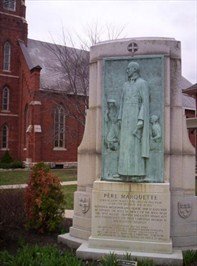Most Reverend Joseph H. L. Schlarman
Third Bishop of Peoria, 1930-1951
The Most Reverend Joseph H.L. Schlarman was born February 23, 1879, in Breese Township in Southern Illinois, tenth child of a German family.
The future bishop received his early training at the hands of Sisters known as the Poor Handmaids of Christ, and also under the direction of his own brother Henry, who was schoolmaster and organist as St. Boniface Parish in Germantown.
After four years at St. Francis Solanus College in Quincy, studying initially medicine, he changed his mind and decided to study theology. There he also became a Franciscan Tertiary: “The Franciscan Fathers lassoed me shortly after my entering Quincy College.” His courses took him to Innsbruck and Rome as well.
Ordained June 29, 1904, in Cathedral in Brixen, Tyrol. Later he was named chancellor at the Cathedral of Belleville, his home diocese.
On June 17, 1930, he was consecrated the Third Bishop of Peoria in the cathedral at Belleville by Cardinal George Mundelein, Archbishop of Chicago.
Despite poor health (he survived fifteen operations and received the Last Sacraments six times), he served the diocese with unusual fervor. Under his guidance, the diocese became better organized and financially secure. Governor Horner appointed Bishop Schlarman a chairman of a commission for the study of prison problems which culminated in his deeply analytic book Why Prisons? He was also actively involved in the National Catholic Rural Life Conference.
In 1934, he launched a largest renovation of St. Mary Cathedral, which, due to the depression years, turned out to be a ten-year-long, but probably his most beloved project called “Redemption”, followed in the smallest details. In it he combined his great love for the Church, liturgy and beauty, along with his desire to teach his flock to appreciate and utilize them in their own life of faith. All his undertakings in the cathedral were explained step by step in the The Peoria Register (later The Catholic Post) which he established in 1934.
A man much ahead of his own time, he tried his best to institute in people love for the liturgy and understanding for the Divine worship. He was one of the few bishops in the United States who were stressing the need of participation at the liturgy by the people, its scripture roots, centrality of the Mass and Sacraments, lay movements, role of music and art in the liturgy. All of these efforts, pioneered by Bishop Schlarman in his time, were re-introduced and implemented during Vatican II.
Among his extra-diocesan activities was promotion of the Montezuma seminary near Las Vegas, which Bishop Schlarman supported and encouraged wholeheartedly. In the footsteps of his predecessors, he was very much interested in the Catholic education. In late 1930’s he started the renowned and successful Peoria-Aledo Plan for catechizing children in rural areas.
Bishop Schlarman was a noted historian and liturgist of nationwide measure. Just a few months before his arrival in Peoria, he had published his best-seller “From Quebec to New Orleans-Story of the French in America” in which he displays his full admiration for the Christian missionaries in the country, particularly Fr. Marquette. In 1951, he thoroughly enjoyed a long-planned glorious celebration of Fr. Marquette’s 300th anniversary in Utica. This personal hero of his was there at the end of his life as well, when only a month later, on November 10, 1951, Bishop Schlarman died suddenly before a morning Mass in his residence.
After one last time in his beloved cathedral, Bishop Schlarman, “falling like a mighty oak”, was buried in the Bishops’ mausoleum at St. Mary Cemetery.
He had been named titular Archbishop a few months before his death.






